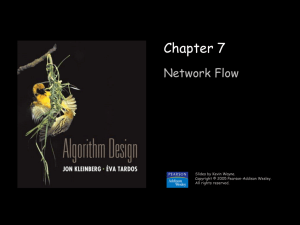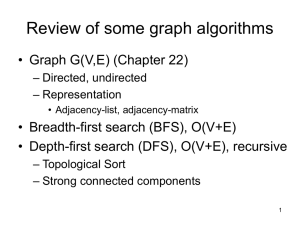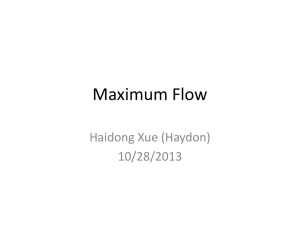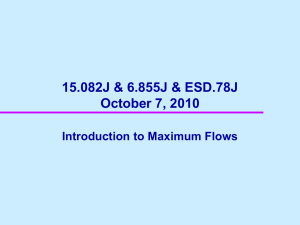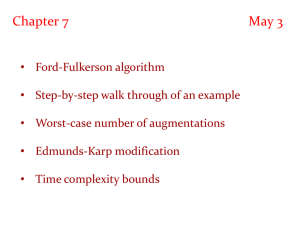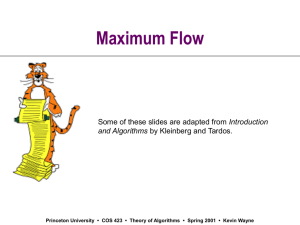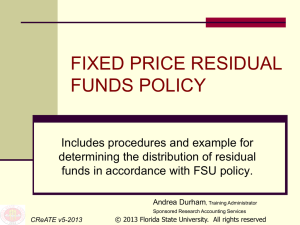NP Completeness
advertisement
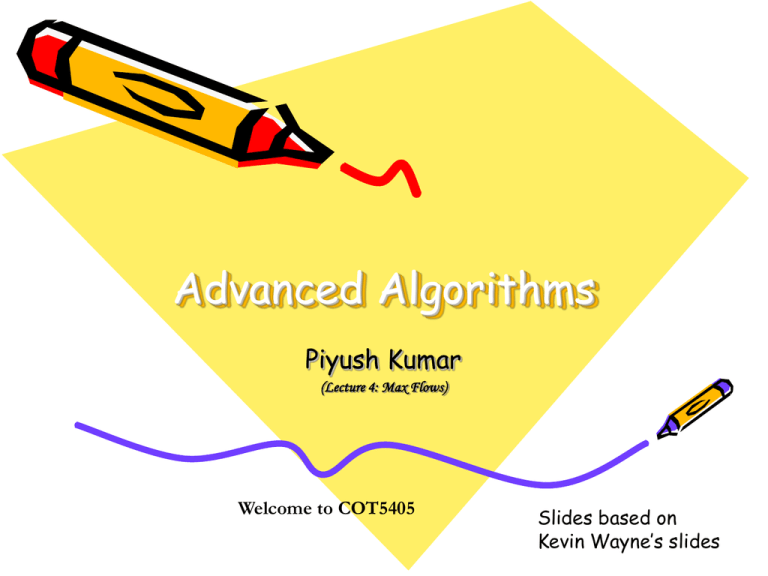
Advanced Algorithms
Piyush Kumar
(Lecture 4: Max Flows)
Welcome to COT5405
Slides based on
Kevin Wayne’s slides
Announcements
• Scribing is worth 5% extra credit.
• Think about your project and project
partner.
• By Thursday, I need the topic and your
partner’s name.
Soviet Rail Network, 1955
“The Soviet rail system also roused the interest of the Americans,
and again it inspired fundamental research in optimization.”
-- Schrijver
G. Danzig* 1951…First soln…
Again formulted by
Harris in 1955 for the
US Airforce
(“unclassified in 1999”)
What were they looking for?
Reference: On the history of the transportation and maximum flow problems.
Alexander Schrijver in Math Programming, 91: 3, 2002.
Maximum Flow and
Minimum Cut
• Max flow and min cut.
– Two very rich algorithmic problems.
– Cornerstone problems in combinatorial
optimization.
– Beautiful mathematical duality.
Applications
- Nontrivial applications / reductions.
- Data mining.
– Network reliability.
- Open-pit mining.
– Distributed computing.
- Project selection.
– Egalitarian stable matching.
- Airline scheduling.
– Security of statistical data.
- Bipartite matching.
– Network intrusion
- Baseball elimination.
detection.
- Image segmentation.
– Multi-camera scene
- Network connectivity.
reconstruction.
- Min Area Surfaces.
– Many many more . . .
Some more history
Implementation Notes
Minimum Cut Problem
• Flow network.
– Abstraction for material flowing through the edges.
– G = (V, E) = directed graph, no parallel edges.
– Two distinguished nodes: s = source, t = sink.
– c(e) = capacity of edge e.
10
source
s
capacity
5
15
2
9
5
4
15
15
10
3
8
6
10
4
6
15
4
30
7
10
t
sink
Cuts
• Def. An s-t cut is a partition (A, B) of V with
s A and t B.
• Def. The capacity of a cut (A, B) is: cap( A, B)
9
5
4
15
15
10
3
8
6
10
4
6
15
2
10
s
5
c(e)
e out ofA
t
A
15
4
30
7
10
Capacity = 10 + 5 + 15
= 30
Cuts
• Def. An s-t cut is a partition (A, B) of V with s
A and t B.
• Def. The capacity of a cut (A, B) is:
10
5
s
A
15
cap( A, B)
e out ofA
2
9
4
15
15
10
3
8
6
10
4
6
15
4
30
c(e)
5
7
t
10
Capacity = 9 + 15 + 8 + 30
= 62
Minimum Cut Problem
• Min s-t cut problem. Find an s-t cut
of minimum capacity.
10
5
s
A
15
2
9
5
4
15
15
10
3
8
6
10
4
6
15
4
30
7
t
10
Capacity = 10 + 8 + 10
= 28
Flows
• Def. An s-t flow is a function that satisfies:
0 f (e) c(e)
– For each e E:
(capacity)
– For each v V – {s, t}: f (e) f (e) (conservation)
e in tov
e out ofv
• Def. The value of aflow f is: v( f )
10
9
4 4
0
5
s
e out of s
0
2
4
f (e) .
0
15
5
0
15
0
4
4
3
8
6
0
capacity
15
flow
0
4 0
6
15 0
0
4
30
10
7
10
t
0
10
Value = 4
Flows as Linear Programs
• Maximize:
v( f )
f (e) .
e out of s
Subject to:
0 f (e) c(e)
f (e)
e in tov
f (e)
e out ofv
Flows
• Def. An s-t flow is a function that satisfies:
0 f (e) c(e) (capacity)
– For each e E:
– For each v V – {s, t}: f (e) f (e)(conservation)
e in tov
f is:
• Def. The value of a flow
10
9
4 4
3
5
s
v( f )
f (e) .
e out of s
6
2
10
e out ofv
0
15
5
6
15
0
8
8
3
8
6
1
capacity
15
flow
11
4 0
6
15 0
11
4
30
10
7
10
t
10
10
Value = 24
Maximum Flow Problem
• Max flow problem. Find s-t flow of
maximum value.
9
2
10
10
4 0
4
5
s
9
1
15
5
9
15
0
9
8
3
8
6
4
capacity
15
flow
14
4 0
6
15 0
14
4
30
10
7
10
t
10
10
Value = 28
Flows and Cuts
• Flow value lemma. Let f be any flow, and let (A, B)
be any s-t cut. Then, the net flow sent across the
cut is equal to the amount leaving s.
f (e) f (e) v( f )
e out ofA
2
10
10
4 4
3
s
5
e in to A
6
9
0
15
5
6
15
0
8
8
3
A
8
6
1
15
4 0
11
6
15 0
11
4
30
10
7
10
t
10
10
Value = 24
Flows and Cuts
• Flow value lemma. Let f be any flow, and let (A, B) be any st cut. Then, the net flow sent across the cut is equal to the
amount leaving s.
f (e) f (e) v( f )
e out ofA
e in to A
6
2
10
10
4 4
3
s
5
9
0
15
5
6
15
0
8
8
3
A
8
6
1
15
4 0
11
6
15 0
11
4
30
10
7
10
t
10
10
Value = 6 + 0 + 8 - 1 + 11
= 24
Flows and Cuts
• Flow value lemma. Let f be any flow, and let (A, B) be any st cut. Then, the net flow sent across the cut is equal to the
amount leaving s.
f (e) f (e) v( f )
e out ofA
e in to A
6
2
10
10
4 4
3
s
5
9
0
15
5
6
15
0
8
8
3
A
8
6
1
15
4 0
11
6
15 0
11
4
30
10
7
10
t
10
10
Value = 10 - 4 + 8 - 0 + 10
= 24
Flows and Cuts
• Flow value lemma. Let f be any flow,
and let (A, B) be any s-t cut. Then
f (e) f (e) v( f ) .
e out ofA
• Pf.
by flow conservation, all terms
except v = s are 0
e in toA
v( f )
f (e)
e out ofs
f (e) f (e)
v A e out ofv
e in to v
f (e) f (e).
e out ofA
e in to A
Flows and Cuts
• Weak duality. Let f be any flow, and let (A, B) be any s-t
cut. Then the value of the flow is at most the capacity of
the cut.
Cut capacity = 30
10
s
5
Flow value 30
2
9
5
4
15
15
10
3
8
6
10
4
6
15
4
30
t
A
15
7
10
Capacity = 30
Flows and Cuts
Weak duality. Let f be any flow. Then, for any s-t cut
(A, B) we have
v(f) cap(A, B).
• Pf.
v( f )
f (e) f (e)
e out ofA
e in toA
f (e)
e out ofA
A
c(e)
4
8
e out ofA
cap(A, B)
s
7
6
B
t
Certificate of Optimality
• Corollary. Let f be any flow, and let (A, B) be any cut.
If v(f) = cap(A, B), then f is a max flow and (A, B) is a min
cut.
Value of flow = 28
Cut capacity = 28
Flow value 28
9
2
9
4
1
15
10
10
0
4
5
s
5
9
15
0
9
8
3
8
6
4
A
15
4 0
14
6
15 0
14
4
30
10
7
10
10
10
t
Towards a Max Flow Algorithm
• Greedy algorithm.
–
–
–
–
Start with f(e) = 0 for all edge e E.
Find an s-t path P where each edge has f(e) < c(e).
Augment flow along path P.
Repeat until you get stuck.
1
0
0
20
10
30 0
s
t
10
20
0
0
2
Flow value = 0
Towards a Max Flow Algorithm
• Greedy algorithm.
–
–
–
–
Start with f(e) = 0 for all edge e E.
Find an s-t path P where each edge has f(e) < c(e).
Augment flow along path P.
Repeat until you get stuck.
1
20 X
0
0
20
10
30 X
0 20
s
t
10
20
0
X
0 20
2
Flow value = 20
Towards a Max Flow Algorithm
• Greedy algorithm.
–
–
–
–
Start with f(e) = 0 for all edge e E.
Find an s-t path P where each edge has f(e) < c(e).
Augment flow along path P.
Repeat until you get stuck.
locally optimality global optimality
1
20
20
s
1
0
10
t
30 20
10
0
greedy = 20
2
20
20
s
20
20
t
30 10
10
10
opt = 30
10
10
2
20
20
Residual Graph
• Original edge: e = (u, v) E.
– Flow f(e), capacity c(e).
capacity
u
v
17
6
flow
• Residual edge.
– "Undo" flow sent.
– e = (u, v) and eR = (v, u).
– Residual capacity:
c(e) f (e) if e E
c f (e)
if e R E
f (e)
residual capacity
u
11
v
6
• Residual graph: Gf = (V, Ef ).
– Residual edges with positive residual capacity.
– Ef = {e : f(e) < c(e)} {eR : f(e) > 0}.
residual capacity
Demo
Augmenting Path Algorithm
Augment(f, c, P) {
b bottleneck(P)
foreach e P {
if (e E) f(e) f(e) + b
else
f(eR) f(e) - b
}
return f
}
forward edge
reverse edge
Ford-Fulkerson(G, s, t, c) {
foreach e E f(e) 0
Gf residual graph
while (there exists augmenting path P) {
f Augment(f, c, P)
update Gf
}
return f
}
Max-Flow Min-Cut Theorem
•
Augmenting path theorem. Flow f is a max flow iff there are no
augmenting paths.
•
Max-flow min-cut theorem. [Ford-Fulkerson 1956] The value of
the max flow is equal to the value of the min cut.
•
Proof strategy. We prove both simultaneously by showing the
TFAE:
(i)
There exists a cut (A, B) such that v(f) = cap(A, B).
(ii)
Flow f is a max flow.
(iii)
There is no augmenting path relative to f.
•
(i) (ii) This was the corollary to weak duality lemma.
•
(ii) (iii) We show contrapositive.
– Let f be a flow. If there exists an augmenting path, then we
can improve f by sending flow along path.
Proof of Max-Flow Min-Cut Theorem
• (iii) (i)
– Let f be a flow with no augmenting paths.
– Let A be set of vertices reachable from s in
residual graph.
– By definition of A, s A.
– By definition of f, t A.
A
B
v( f )
f (e) f (e)
e out ofA
t
e in to A
c(e)
e out ofA
cap(A, B)
s
original network
Running Time
•
Assumption. All capacities are integers between 1 and U. The cut
containing s and rest of the nodes has C capacity.
•
Invariant. Every flow value f(e) and every residual capacities cf (e)
remains an integer throughout the algorithm.
•
•
Theorem. The algorithm terminates in at most v(f*) C iterations.
Pf. Each augmentation increase value by at least 1. ▪
•
Corollary. If C = 1, Ford-Fulkerson runs in O(m) time.
•
Integrality theorem. If all capacities are integers, then there
exists a max flow f for which every flow value f(e) is an integer.
Pf. Since algorithm terminates, theorem follows from invariant. ▪
•
Total running time?
7.3 Choosing Good
Augmenting Paths
32
Ford-Fulkerson: Exponential Number of
Augmentations
• Q. Is generic Ford-Fulkerson algorithm polynomial in input
size?
m, n, and log C
• A. No. If max capacity is C, then algorithm can take C
iterations.
1
1
1
0
X
0
C
C
1 X
0 1
s
t
C
C
0
0 1
X
2
1
X
0
0 1
X
C
C
1 0
1 X
0 X
s
t
C
C
X
0 1
0
1 X
2
Choosing Good Augmenting Paths
• Use care when selecting augmenting paths.
– Some choices lead to exponential algorithms.
– Clever choices lead to polynomial algorithms.
– If capacities are irrational, algorithm not guaranteed to
terminate!
• Goal: choose augmenting paths so that:
– Can find augmenting paths efficiently.
– Few iterations.
• Choose augmenting paths with: [Edmonds-Karp 1972, Dinitz 1970]
– Max bottleneck capacity.
– Sufficiently large bottleneck capacity.
– Fewest number of edges.
Capacity Scaling
• Intuition. Choosing path with highest bottleneck capacity
increases flow by max possible amount.
– Don't worry about finding exact highest bottleneck
path.
– Maintain scaling parameter .
– Let Gf () be the subgraph of the residual graph
consisting of only arcs with capacity at least .
4
110
4
102
1
s
122
t
170
2
Gf
110
102
s
t
122
170
2
Gf (100)
Capacity Scaling
Scaling-Max-Flow(G, s, t, c) {
foreach e E f(e) 0
smallest power of 2 greater than or equal to max c
Gf residual graph
while ( 1) {
Gf() -residual graph
while (there exists augmenting path P in Gf()) {
f augment(f, c, P)
update Gf()
}
/ 2
}
return f
}
Capacity Scaling: Correctness
• Assumption. All edge capacities are integers
between 1 and C.
• Integrality invariant. All flow and residual capacity
values are integral.
• Correctness. If the algorithm terminates, then f is
a max flow.
• Pf.
– By integrality invariant, when = 1 Gf() =
Gf.
– Upon termination of = 1 phase, there are no
augmenting paths. ▪
Capacity Scaling: Running Time
• Lemma 1. The outer while loop repeats 1 + log2 C times.
• Pf. Initially < C. drops by a factor of 2 each iteration and
never gets below 1.
• Lemma 2. Let f be the flow at the end of a -scaling phase.
Then the value of the maximum flow is at most v(f) + m .
proof on next slide
• Lemma 3. There are at most 2m augmentations per scaling
phase.
– Let f be the flow at the end of the previous scaling phase.
– L2 v(f*) v(f) + m (2).
– Each augmentation in a -phase increases v(f) by at least .
• Theorem. The scaling max-flow algorithm finds a max flow in
O(m log C) augmentations. It can be implemented to run in
O(m2 log C) time. ▪
Capacity Scaling: Running Time
• Lemma 2. Let f be the flow at the end of a -scaling phase.
Then value of the maximum flow is at most v(f) + m .
• Pf. (almost identical to proof of max-flow min-cut
theorem)
– We show that at the end of a -phase, there exists a
cut (A, B) such that cap(A, B) v(f) + m .
– Choose A to be the set of nodes reachable from s in
Gf().
– By definition of A, s A.
A
B
– By definition of f, t A.
t
v( f )
f (e) f (e)
e out ofA
e in to A
(c(e) )
e out ofA
c(e)
e out ofA
s
e in toA
e out ofA
cap(A, B) - m
e in toA
original network
Bipartite Matching
• Bipartite matching. Can solve via reduction to max flow.
• Flow. During Ford-Fulkerson, all capacities and flows are
0/1. Flow corresponds to edges in a matching M.
1
• Residual graph GM simplifies to:
s
– If (x, y) M, then (x, y) is in GM.
– If (x, y) M, the (y, x) is in GM.
1
1
t
X
• Augmenting path simplifies to:
– Edge from s to an unmatched node x X.
– Alternating sequence of unmatched and matched edges.
– Edge from unmatched node y Y to t.
Y
References
• R.K. Ahuja, T.L. Magnanti, and J.B. Orlin. Network Flows.
Prentice Hall, 1993. (Reserved in Dirac)
• R.K. Ahuja and J.B. Orlin. A fast and simple algorithm for
the maximum flow problem. Operation Research, 37:748759, 1989.
• K. Mehlhorn and S. Naeher. The LEDA Platform for
Combinatorial and Geometric Computing. Cambridge
University Press, 1999. 1018 pages.
• On the history of the transportation and maximum flow
problems, Alexander Schrijver.
